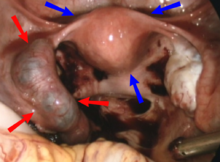Hämatosalpinx – Wikipedia
| Klassifikation nach ICD-10 | |
|---|---|
| N83.6 | Hämatosalpinx |
| ICD-10 online (WHO-Version 2019) | |
Die Hämatosalpinx (von altgriechisch αἷμα haima, deutsch ‚Blut‘ und altgriechisch σαλπίγξ salpinx, deutsch ‚Eileiter‘) ist eine Ansammlung von Blut in einem oder in beiden Eileitern (lateinisch Tuba uterina).[1]

Ursache
[Bearbeiten | Quelltext bearbeiten]Als Ursache kommen infrage:[2]
- Eileiterschwangerschaft
- Endometriose, die beiden häufigsten Ursachen
- Salpingitis und andere Entzündungen im Becken
- Tubentorsion (Verdrehung des Eileiters um die eigene Längsachse)
- Tubenkarzinom
- Trauma
- als Komplikation bei einem Hämatokolpos
Klinische Erscheinungen
[Bearbeiten | Quelltext bearbeiten]Die klinischen Kriterien hängen von der Ursache ab, siehe jeweils dort.
Diagnose
[Bearbeiten | Quelltext bearbeiten]Der erste und wegweisende diagnostische Schritt nach der klinischen Untersuchung ist die Sonografie. Häufig wird eine Laparoskopie notwendig sein.
Literatur
[Bearbeiten | Quelltext bearbeiten]- M. Nacharaju, V. S. Vellanki, S. B. Gillellamudi, V. K. Kotha, A. Alluri: A rare case of chronic ectopic pregnancy presenting as large hematosalpinx. In: Clinical medicine insights. Reproductive health, 2014, Band 8, S. 1–4; doi:10.4137/CMRH.S13110, PMID 24812530, PMC 4007565 (freier Volltext).
- C. L. Diehl, L. P. Gavrilova-Jordan, C. C. Coddington: Acute abdominal pain as a result of a ruptured hematosalpinx: a rare complication of an unusual müllerian anomaly. In: Journal of pediatric and adolescent gynecology, Juni 2009, Band 22, Nr. 3, S. e9–11; doi:10.1016/j.jpag.2008.02.005, PMID 19539197.
- T. Römer, B. Bojahr, G. Schwesinger: Treatment of a torqued hematosalpinx in the thirteenth week of pregnancy using gasless laparoscopy. In: The Journal of the American Association of Gynecologic Laparoscopists, Februar 2002, Band 9, Nr. 1, S. 89–92, PMID 11821614.
Weblinks
[Bearbeiten | Quelltext bearbeiten]Einzelnachweise
[Bearbeiten | Quelltext bearbeiten]- ↑ Willibald Pschyrembel: Klinisches Wörterbuch. 266., aktualisierte Auflage. de Gruyter, Berlin 2014, ISBN 978-3-11-033997-0
- ↑ Radiopaedia


 French
French Deutsch
Deutsch